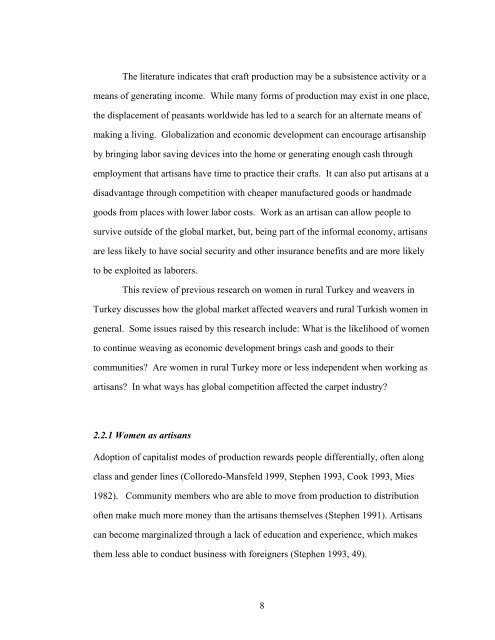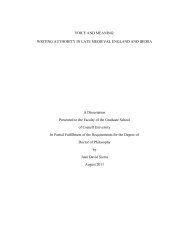CARPET WEAVERS AND WEAVING IN THE ... - Cornell University
CARPET WEAVERS AND WEAVING IN THE ... - Cornell University
CARPET WEAVERS AND WEAVING IN THE ... - Cornell University
Create successful ePaper yourself
Turn your PDF publications into a flip-book with our unique Google optimized e-Paper software.
The literature indicates that craft production may be a subsistence activity or a<br />
means of generating income. While many forms of production may exist in one place,<br />
the displacement of peasants worldwide has led to a search for an alternate means of<br />
making a living. Globalization and economic development can encourage artisanship<br />
by bringing labor saving devices into the home or generating enough cash through<br />
employment that artisans have time to practice their crafts. It can also put artisans at a<br />
disadvantage through competition with cheaper manufactured goods or handmade<br />
goods from places with lower labor costs. Work as an artisan can allow people to<br />
survive outside of the global market, but, being part of the informal economy, artisans<br />
are less likely to have social security and other insurance benefits and are more likely<br />
to be exploited as laborers.<br />
This review of previous research on women in rural Turkey and weavers in<br />
Turkey discusses how the global market affected weavers and rural Turkish women in<br />
general. Some issues raised by this research include: What is the likelihood of women<br />
to continue weaving as economic development brings cash and goods to their<br />
communities? Are women in rural Turkey more or less independent when working as<br />
artisans? In what ways has global competition affected the carpet industry?<br />
2.2.1 Women as artisans<br />
Adoption of capitalist modes of production rewards people differentially, often along<br />
class and gender lines (Colloredo-Mansfeld 1999, Stephen 1993, Cook 1993, Mies<br />
1982). Community members who are able to move from production to distribution<br />
often make much more money than the artisans themselves (Stephen 1991). Artisans<br />
can become marginalized through a lack of education and experience, which makes<br />
them less able to conduct business with foreigners (Stephen 1993, 49).<br />
8

















